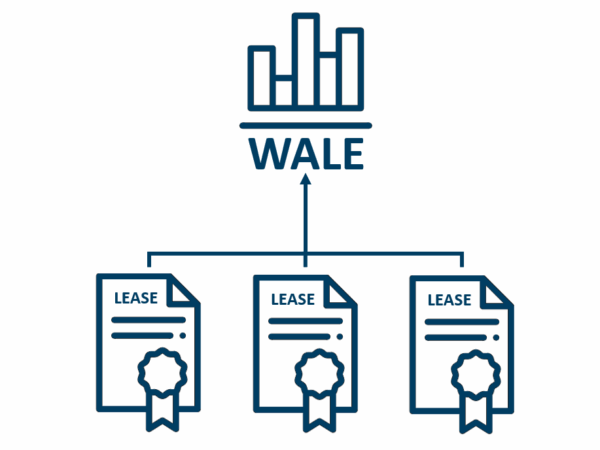The weighted average lease expiry (or WALE) is one single number that shows a (more relevant) average of many leases. These leases can cover one property or many properties.
In an ordinary average, each of the lease expiries contributes equally to the final number.
In a weighted average, some lease expiries contribute more than others.
Weighted average lease expiry is one measure of the quality of the property’s cash flows: it points to the predictability of future contracted revenues.
WALE is the same as WAULT, short for weighted average unexpired lease term, and WALT (weighted average lease term).
Example of weighted average lease expiry
One property with many leases, of different sizes, and different expiry dates
- Lease 1 | 1,000 sqm | 12 months
- Lease 2 | 5,000 sqm | 36 months
- Lease 3 | 4,000 sqm | 48 months
The total space is 10,000 sqm.
Average value: 32.0 months
Calculation: ( 12 months + 36 months + 48 months) / 3 leases = 32.0 months
Weighted average value: 38.4 months
Calculation: ( lease 1’s 1,000 sqm / total 10,000 sqm x 12 months ) + (lease 2’s 5,000 sqm / total 10,000 sqm x 36 months ) + (lease 3’s 4,000 sqm / total 10,000 sqm x 48 months ) = 38.4 months
Note: in the above, we have weighted the lease expiries by space.
Instead of space (first variable below), lease expiries can be weighted, using the same principles as above, by other values:
- Space (for example GLA or rentable area, or usable area)
- Total monthly lease rental value (e.g. R / sqm x sqm)
- Gross rental / sqm / month
- NPV of future gross rentals (taking into account including escalations)
In other words, the space value in our calculation above can be substituted with each of the above (or others), as is most meaningful and appropriate to users of your calculation.







